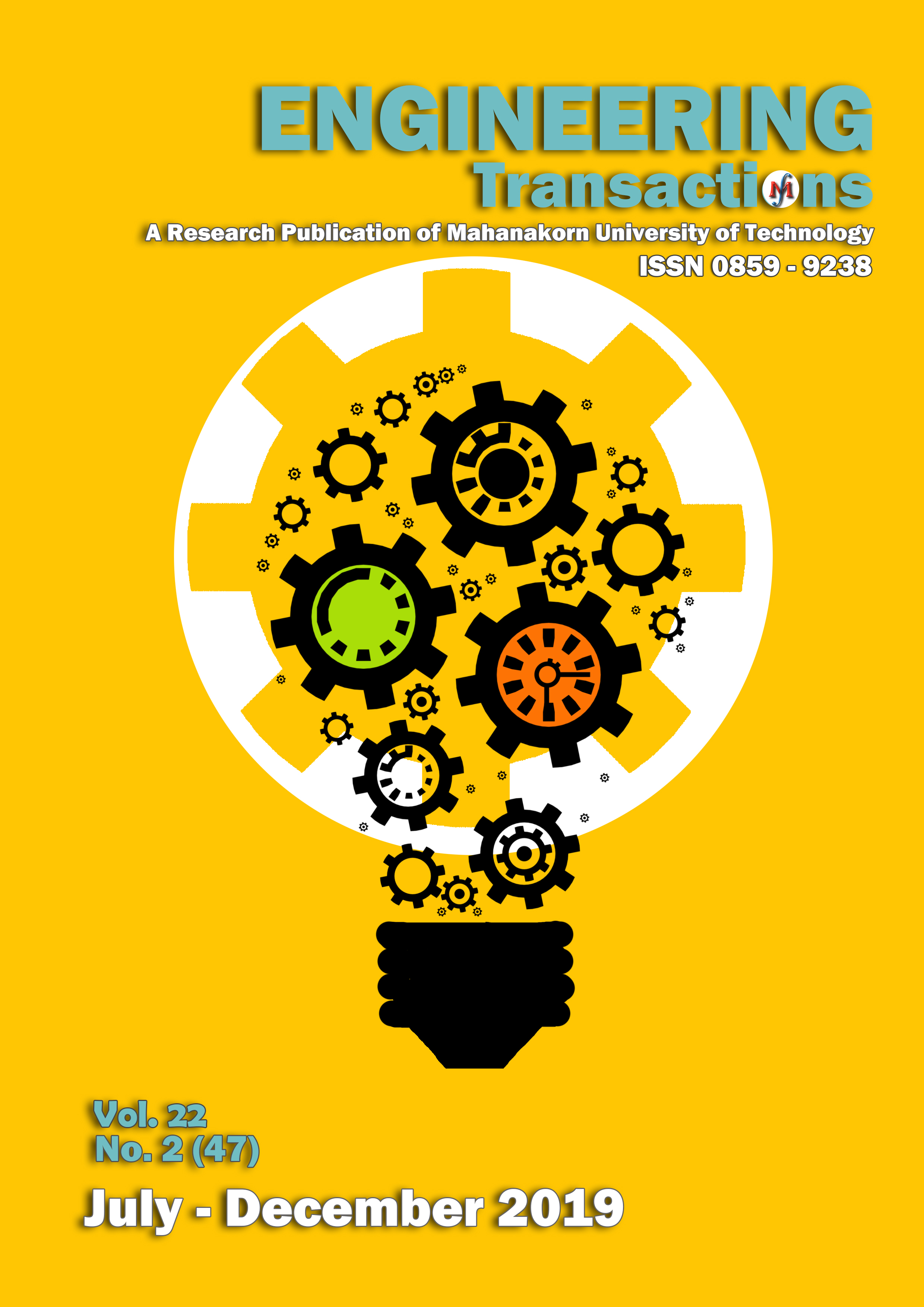การศึกษาทัศนคติในมุมมองของพนักงานที่มีผลต่อการทำงานจากที่บ้าน
Main Article Content
บทคัดย่อ
งานวิจัยนี้เป็นการศึกษาการศึกษาทัศนคติในมุมมองของพนักงานที่มีต่อการทำงานจากที่บ้านโดยแบบจำลองที่ดัดแปลงจากทฤษฎีการยอมรับด้านเทคโนโลยีแบบจําลองการยอมรับเทคโนโลยี (Technology Acceptance Model: TAM) โดยผู้วิจัยได้ทำการศึกษาข้อมูลเกี่ยวกับปัจจัยต่างๆ ที่อาจก่อให้เกิดการทำงานจากที่บ้านไม่ว่าจะเป็น ด้านความเจริญก้าวหน้าทางเทคโนโลยี ซึ่งในประเทศไทยมีอัตราการเข้าถึงอินเทอร์เน็ตเพิ่มขึ้นจากในอัตราร้อยละ 82 ของประชากรทั้งหมด นอกจากนี้ผู้วิจัยยังได้ศึกษาถึงปัญหามลภาวะทางอากาศเป็นพิษ เนื่องจากในช่วงปี 2562 ได้เกิดวิกฤตการณ์ PM 2.5 ที่ส่งผลกระทบต่อการใช้ชีวิตประจำวันของคนในประเทศไทยอย่างมาก ซึ่งค่าความหนาแน่นมลพิษ ในกรุงเทพมหานคร ติดอันดับ 8 ใน 10 ของโลก ส่วนใหญ่มาจากปัญหารถติดสะสมบนท้องถนน
ซึ่งนอกจากปัจจัยข้างต้นแล้วนั้น ผู้วิจัยได้ศึกษาเพิ่มเติมในปัจจัยด้านทัศนคติ และแนวคิดนโยบายองค์กร (Corporate Policy) และปฎิบัติงานของพนักงาน (Job Performance) ที่ถือได้ว่าเป็นปัจจัยหนึ่งที่ส่งผลต่อการยอมรับการทำงานจากที่บ้าน เพื่อเป็นแนวทางในการพัฒนาให้เกิดการยอมรับและนำระบบการทำงานจากที่บ้านมาปรับใช้ในอนาคตได้ โดยได้ดำเนินการเก็บแบบสอบถามจำนวนประชากรที่เคยทำงานจากที่บ้านจำนวน 400 คน เพื่อนำมาใช้ในการวิเคราะห์ข้อมูลแบบ T-test, One-Way Anova และการวิเคราะห์การถดถอยเชิงพหุ (Multiple Regression) โดยกำหนดปัจจัยไว้ 5 ด้านคือ 1) ด้านการรับรู้ประโยชน์ 2) ด้านการรับรู้ถึงการใช้งานง่าย 3) ปัจจัยด้านความสอดคล้อง 4) ปัจจัยด้านการปฏิบัติงานของพนักงาน และ 5) ปัจจัยด้านนโยบายองค์กร โดยมีนัยสำคัญทางสถิติที่ระดับ 0.05
Article Details
บทความนี้เป็นลิขสิทธิ์ของวารสาร Engineering Transactions คณะวิศวกรรมศาสตร์และเทคโนโลยี มหาวิทยาลัยเทคโนโลยีมหานคร
เอกสารอ้างอิง
กัลยา วานิชย์บัญชา และฐิตา วานิชย์บัญชา. (2561).การใช้ SPSS ในการวิเคราะห์ข้อมูล. กรุงเทพฯ .ศูนย์หนังสือแห่งจุฬาลงกรณ์มหาวิทยาลัย
กัลยาณี สุขวาณิชย์ศิลป์. (2553). ทัศนคติต่ออการยอมรับระบบเทคโนโลยีสารสนเทศ FMS (Franchise Management System) บริษัท ซีพี ออลล์ จํากัด (มหาชน)
ชาลิณี ฐิติโชติพณิชย์.(2559). ปัจจัยที่มีอิทธิพลต่อการใช้ระบบการทำงานทางไกล (Telework) ของพนักงาน กรณีศึกษาบริษัทเอกชนแห่งหนึ่ง ในเขตกรุงเทพมหานคร
บังอรรัตน์ สำนียงเพราะ.(2554). ปัจจัยที่มีผลต่อการยอมรับและพฤติกรรมใช้เทคโนโลยีสำนักงานเสมือน กรณีศึกษา: หน่วยงานปฏิบัติการภาคสนาม องค์กรผู้ให้บริการโทรศัพท์เคลื่อนที่
พยนต์ ไกรนุยะฉันท์.(2556). การค้นคว้าประสิทธิผลการเรียนการสอนทางไกลของระบบ BU WebEx
มนัสนันท์ ศรันาคร และ พิชิต พิทักษ์เทพสมบัต.(2553) “การทำงานทางไกลและที่บ้าน”, วารสารการจัดการสิ่งแวดล้อม, ปีที่ 6, ครั้งที่ 1, หน้า 109-118.
วลัญช์ ก้าวสัมพันธ์.(2555). ปัจจัยที่มีผลต่อทัศนคติและการยอมรับการทำงานระยะไกล: กรณีศึกษา ธนาคารแห่งประเทศไทย
สุชาดา เกยุระ.(2553). การประยุกต์ใช้ Technology Acceptance Model และ Task-Technology Fit ใน E-learning
สำนักงานนโยบายและแผนพลังงาน กระทรวงพลังงาน.(2561). รายงานสถิติพลังงานของประเทศไทย 2561, กรุงเทพมหานคร, หน้า 1- 734
Ajzen, I., and Fishbein, M. A. (1975). “Belief, attitude, intention and behavior: An introduction to theory and research.” Publisher: Reading, MA: Addison-Wesley Researchgate, pp.1-50.
Clark II, S. D., and Olfman, L. (1999). “Influencing the decision to telework—testing the simplified decision model”, SIGCPR '99 Proceedings of the 1999 ACM SIGCPR conference on Computer personnel research, pp. 65-72.
Davis, F. D. (1989). “Perceived usefulness, perceived ease of use, and user acceptance of information technology”, MIS quarterly 13(3) Retrieved from JSTOR Database, pp. 319-340.
Lim, V. K., and Teo, T. S. (1999) “To Work or Not to Work at Home An Empirical Investigation of Factors Affecting Attitudes Towards Teleworking”, Journal of Managerial Psychology, Vol. 15, No. 6, pp. 560-586.
Mahmassani, H. S., et al. (1993) “Employee Attitudes and Stated Preferences Towards Telecommuting: An Exploratory Analysis”, Transportation Research Record 1413, pp. 31-41.
Martin, B. H., and MacDonnell, R. (2012). “Is telework effective for organizations? A meta-analysis of empirical research on perceptions of telework and organizational outcomes”, Management Research Review, Vol. 35, No. 7, pp. 602-616.3.
Ndubisi, O. N. and Kahraman, C. (2005) “Teleworking adoption decision-making processes Multinational and Malaysian firms comparison”, The Journal of Enterprise Information Management, Vol. 18, No. 2, pp. 150-168.
Pérez, P. M., et al., 2004, “A technology acceptance model of innovation adoption: the case of teleworking”, European Journal of Innovation Management, Vol. 7, • No. 4, pp. 280-291.
Smith, J. and Gardner, D. (2007). “Factors Affecting Employee Use of Work-Life Balance Initiatives”, New Zealand Journal of Psychology, Vol. 36, No.1,pp. 3-12.


